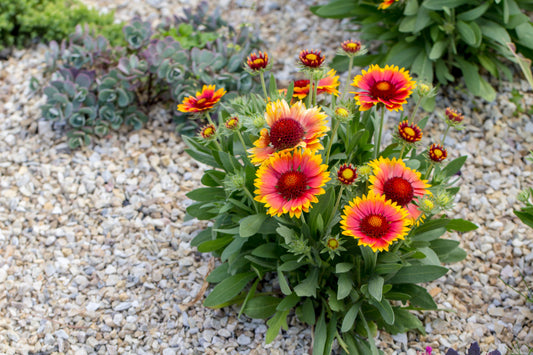Begonia Planting & Growing Guide
Planting Guide Information
-
1/2"Planting Depth
-
10-12" ApartPlanting Proximity
-
SpringPlanting Season
-
Begonias do well in containers, covered patios and along borders.Plant Benefits
-
ModerateWater Quantity
-
Summer through FallBloom Season
-
Partial Sun to Partial ShadeSunlight Quantity
-
Zones 9-11 or indoorsHardiness Zones
Additional Growing Information
Where to Plant
Begonias are lovely flowers that are well-suited to shady garden spaces, underneath trees, or in containers placed in areas of your porch, patio, or yard that offer protection from afternoon sunlight. They grow best in light, fertile, well-drained soil and will not survive when waterlogged. If you notice water puddles 5–6 hours after a hard rain, scout out another site or amend the soil with organic material such as compost, finely ground bark, or composted manure.
When to Plant
Begonia tubers perform best when planted in the spring about 8–12 weeks before the average last frost date in your area. If you're gardening in zones 2–8, you can start your tubers indoors in a container for earlier blooms. As tropical plants, Begonias should not be transplanted or moved outside until the weather warms and overnight temperatures are above 60 degrees.
How to Plant
- For container planting, select a container with adequate drainage holes that's large enough to support the mature sizes of the varieties you have chosen. Fill your container with good quality, well-draining soil and loosen it a bit before tucking your tubers in without completely covering them. Plant the tubers 10–12" apart with the indented side, which is where leaf sprouts will form, facing up.
- For outdoor landscape planting, select a spot where the soil drains well, and your Begonias will receive partial shade. Loosen the soil a bit and plant your tubers by simply tucking them in without completely covering them. Plant the tubers 8–12" apart with the indented side, which is where leaf sprouts will form, facing up.
- Water generously after planting to settle the soil around the tubers.
How to Grow
- Water your Begonia during active growth enough to keep the soil damp but never soggy.
- Leave the foliage in place after blooming has finished for the season. The leaves will gather sunlight to create food through photosynthesis, strengthening the plants for the future.
- Remove foliage and stalks when the leaves turn yellow and die back to give your Begonia a clean slate before beginning the next growing cycle.
- Dig up the tubers before the first frost if you live in a colder climate and store them in a cool place in paper bags filled with peat moss.
- Allow your Begonia to rest for a few months before beginning the next growing cycle.
Begonia Tips & Tricks
- Pinch off a few blooms during active growth to float in a bowl of water for a lovely indoor display. However, if you want to include foliage, cut sparingly as these leaves are needed to nourish the bulb for next year's show.
- Amend soil with compost, finely ground bark, or composted manure as needed to avoid water-logging your Begonia.
- Bear in mind that the hotter your growing region, the more shade they prefer.
- Overwinter your tubers indoors for years of spectacular blooms.
- Expect roots and sprouts to form a few weeks after planting, depending on the soil quality and air temperature.
From the Family
-
 15% OffPreorder
15% OffPreorderBegonia - Picotee White Pink
3 large Begonia tubersRegular price $21.21Sale price $21.21 Regular priceUnit price per$24.9415% OffPreorder -
 15% OffPreorder
15% OffPreorderBegonia - Picotee Sunburst
3 large Begonia tubersRegular price $21.21Sale price $21.21 Regular priceUnit price per$24.9415% OffPreorder -
 15% OffPreorder
15% OffPreorderBegonia - Giant Ruffled Red
3 large Begonia tubersRegular price $21.21Sale price $21.21 Regular priceUnit price per$24.9515% OffPreorder -
 15% OffPreorder
15% OffPreorderBegonia - Cascade Mix
6 Begonia tubers, mixed colors.Regular price $33.96Sale price $33.96 Regular priceUnit price per$39.9515% OffPreorder -
 15% OffPreorder
15% OffPreorderBegonia - Picotee Lace Apricot
3 large Begonia tubersRegular price $21.21Sale price $21.21 Regular priceUnit price per$24.9415% OffPreorder








